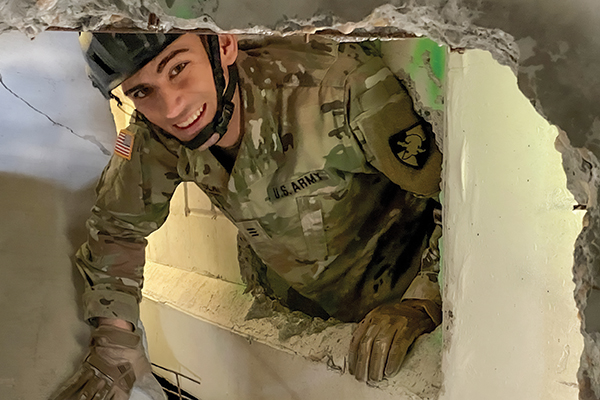By MAJ Brandon Clumpner ’13, CPT Terry Lee ’17, 2LT Spenser Haslam ’24, and Dr. Gunnar Tamm, Guest Authors
Starting on R-day, all new cadets begin to internalize the adage “collaborate to graduate,” which includes forming shared experiences with their classmates and eventually bonding with fellow alums while serving domestically or abroad (and even at the Army-Navy Game). The West Point experience develops this spirit of collaboration in all graduates.
Working together to share resources and solve problems pays immediate dividends for graduates when they are Army officers, and their impact can extend much further to the Army enterprise, industry, and society. Graduates have long reached out to current West Point faculty and cadets to solve real Army problems, recognizing the intellectual capital they can provide, as well as the value added to the 47-month cadet experience.
Spirit of Collaboration and Interdisciplinary Work
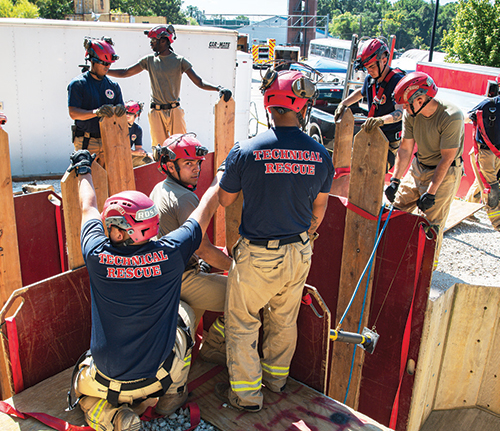
Interconnection and collaboration are not only baked into the cadet experience but also faculty research and USMA’s public messaging. Brigadier General Shane Reeves ’96, Dean of the Academic Board, premiered a new West Point Press podcast in March 2023 called “Inside West Point: Ideas that Impact.” This monthly podcast highlights the applied research and cross disciplinary work of West Point scholars, regarding topics such as high energy lasers, artificial intelligence, arctic research, and modern applications of the law of armed conflict. West Point scholars consistently produce intellectual capital for the Army and industry, and this new podcast makes their work digestible to a wide audience, as listeners hear directly from experts as they converse with the Dean.
Graduates have many opportunities to engage with West Point faculty and cadets. These opportunities include creating a summer internship through an Academic Individual Advanced Development (AIAD) project, mentoring cadets during Cadet Troop Leadership Training (CTLT), volunteering with the Directorate of Admissions as a Field Force representative and requesting cadet and faculty research teams to solve organizational and tactical problems through independent study and capstone projects. These strong relationships provide endless opportunities for impact.
The best projects are those that directly benefit soldiers and make the Army a more effective force. Such projects inspire cadets (and their faculty advisers) and build a strong sense of morale for the project teams. There is nothing more rewarding to cadets than knowing that the technology they are developing today will be the technology they use as officers tomorrow. Two recent projects within the Department of Civil and Mechanical Engineering highlight how old grads have reached back with real Army needs that current cadets then innovated to solve.
Concrete Breaching for Rescue Operations
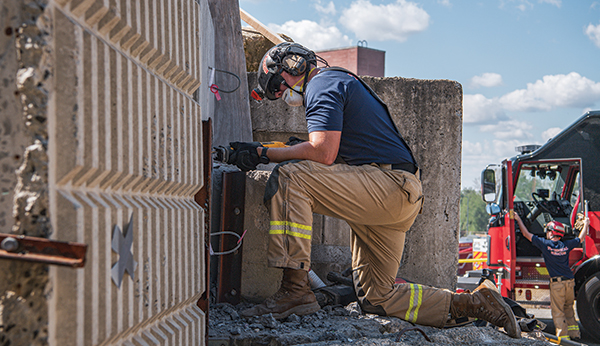
THE ARMY NEED—The 911th Technical Rescue Engineer Company (TREC) is the Department of Defense’s only TREC and keeps a constant readiness posture to perform on-call technical rescue of DoD senior leaders and supporting agencies in the National Capital Region. Soldiers in the 911th TREC are federally certified in five disciplines: rope, trench, and mine rescue; structural collapse; and confined space. Structural collapse often requires breaching multiple wood, concrete, or metal structures to access a trapped individual. Concrete thicker than 18 inches poses a particularly tough problem for the 911th TREC and first responders, as it often takes more than three hours for an experienced team to make a breach with modern equipment in even ideal conditions. Rescue operations are extremely time sensitive, and shortening rescue time can have compounding effects on the health and welfare of those trapped. Successfully solving this problem can have far-reaching impact throughout the first responder community, particularly the FEMA Urban Search and Rescue task forces.
THE ALUMNI CONNECTION—The alumni connection for this need has been decades in the making. Captain Terry Lee ’17, who majored in mechanical engineering as a cadet, currently commands the 911th TREC. Since Branch Night in 2016, one of Lee’s longtime mentors has been Lieutenant Colonel Brian Smith ’97 (Retired). The two remained in contact after Lee graduated, commissioned, and matriculated through the Army, and they usually connect in person at the Army-Navy Game. When Lee received orders to the 911th TREC at Fort Belvoir, Virginia in 2022, Smith offered to connect him to Colonel Aaron Hill ’97, the Deputy Head of the Civil & Mechanical Engineering Department (CME) and Smith’s classmate. Hill commanded the 911th TREC previously. Dr. Gunnar Tamm, who taught in CME while Lee was a cadet, agreed to serve as the faculty adviser, and then-Cadet Spenser Haslam ’24, who eventually chose to branch Engineers, selected the 911th TREC problem for an independent study experience. CME faculty members Major Brett Rocha ’12 and Dr. Nathaniel Helminiak served as co-advisers.
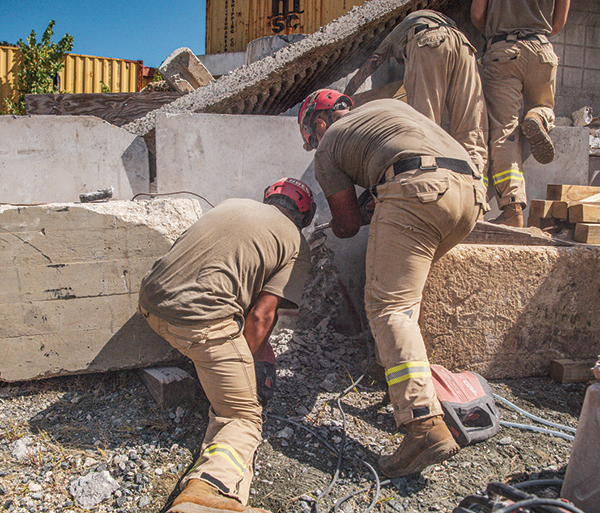
THE USMA SOLUTION—After an initial kickoff meeting, the project team took a day trip to Fort Belvoir, Virginia to observe the 911th TREC during Exercise Capital Shield 2023, the unit’s annual mission validation event. The USMA team talked to company leaders, observed soldiers breaching concrete of various thickness (up to 18 inches), and met with first responders and experts. By crawling through a simulated building collapse, the USMA team experienced first-hand the challenges for rescuers in confined spaces.
Concrete breaching is currently performed by drills, saws and jackhammers. Haslam proposed multiple alternatives to breach the concrete rapidly, and three were studied in greater depth, each prioritizing the safety of the trapped victims and the rescue team. First, using DoD computational software and high-speed computers, the team studied various configurations and placements of shaped charges, which they found to be plausible to rapidly breach but posed too great a risk for the personnel.
Next, the team built high strength, reinforced concrete specimens and cut through them with an industrial water jet cutter. The process was deemed to take too long and would require a tether of pressurized water. Lastly, using computer simulation, the team found that the most feasible solution would be inserting a hydraulic splitter into a drilled hole, which would embrittle the concrete more rapidly than using conventional tools. While no solution was necessarily better than the current methods, finding out what would not work was equally valuable.
Thermal Lance Breaching of Fortified Targets

THE ARMY NEED—Military breaching operations in complex environments require both a precision and accuracy that cannot be attained with the traditional solution of explosives. This problem is currently solved with a handheld thermal lance system, which is an incredibly high-temperature torch that burns solid metal with oxygen. However, the handheld system exposes users to a harmful environment and consumes resources inefficiently. Thermal protection must be worn: apparel guards against molten slag, eye protection against harmful light, and a breathing apparatus against toxic fumes. The Army need is to create an autonomous thermal lance system that is effective, user friendly, efficient, and portable and that would allow soldiers to breach through complex hardened steel structures. An autonomous system reduces the number of soldiers required for these operations as well as the time they spend in dangerous environments.

THE ALUMNI CONNECTION—Cadets that work on capstone projects maintain a lasting relationship with their former advisers. Then-Cadet Griffin Gerchman ’17 was a Mechanical Engineering major working with Dr. Tamm on a project funded by the Combat Capabilities Development Command Armaments Center at Picatinny Arsenal, New Jersey. As a captain, Gerchman became involved with a combat breaching team a few years ago and identified the challenges of using a thermal lance torch. With Picatinny establishing initial funding, this became a multi-year capstone that has since garnered additional Army interest. Co-advisers with Dr. Tamm on this project have included Major Jonathan Kralick ’09 and Major Brandon Clumpner ’13, also graduates of CME. Kralick and Clumpner have commanded user teams and have made further connections to the expert breachers.
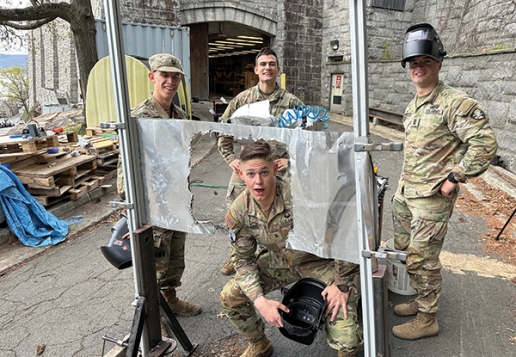
THE USMA SOLUTION—The cadet teams have overcome challenges that skeptics within the Army said were in insurmountable and did not want to support. With minimal user involvement, the cadets’ device can now load a fresh fuel rod, enable oxygen flow, ignite the rod with a spark, move to engage the target, maneuver the burning rod with a six-axis robotic arm, turn off the oxygen when the rod is spent, discard the spent rod, and cycle back with a fresh rod to continue breaching. The 2024 team—with now-Second Lieutenants Spenser Haslam, Charlie Kleinschmidt, Jake Pinuelas and Tanner Traugutt (all Class of 2024 Mechanical Engineering majors)—named their device the Automated Robotic System for Obstacle Neutralization (ARSON). As cadets, they won the Scott R. Clark (USMA Class of 1985) Innovation for Soldiers Award, given out annually to one project during the Academy’s Annual Projects Day Research Symposium, and are seeking patent protection. A future cadet team will make the system smarter, with more sensors and advanced programming.
Conclusion
Opportunities for cadets and faculty to solve challenges and provide intellectual capital to the Army exist in every department. Alumni are encouraged to stay connected to the Academy, learn what USMA’s evolving capabilities are, and pose challenges for West Point to consider while educating and developing leaders of character for the nation.
Photo 1: Then-CDT Spenser Haslam ’24 crawls through a concrete breach during the 911th TREC’s annual training event, Exercise Capital Shield, which was held at the Washington, DC Fire and EMS Training Academy in September 2023. Photo 2: U.S. soldiers assigned to 911th Technical Rescue Engineer Company participate in urban search and rescue training during Exercise Capital Shield 2023 at the Washington, D.C. Fire and EMS Training Academy. Photo 3: A U.S. soldier assigned to 911th Technical Rescue Engineer Company drills into concrete while participating in urban search and rescue training during Exercise Capital Shield 2023 at the Washington, DC Fire and EMS Training Academy. Photo 4: U.S. soldiers assigned to 911th Technical Rescue Engineer Company use tools to create an entry point while participating in urban search and rescue training during Exercise Capital Shield 2023 at the Washington, DC Fire and EMS Training Academy. Photo 5: The ARSON system’s robotic arm uses an 8,000-degree flame to pierce two-inch thick steel in seconds. Photo 6: Cadets from the 2024 Team ARSON capstone project enjoy victory after a successful test of their robotic system, which won the Scott R. Clark (USMA ’85) Innovation for Soldiers Award at the 2024 West Point Annual Projects Day Research Symposium.
MAJ Brandon Clumpner ’13 has taught at West Point since 2022 within the Department of Civil & Mechanical Engineering, where he is an instructor. His research interests include advanced manufacturing, biomechanics, and field expedient capabilities. He earned his M.S. from the Naval Postgraduate School and his B.S. from USMA.
CPT Terry Lee ’17 is an engineer officer currently serving as the commander of the 911th Technical Rescue Engineer Company at Fort Belvoir, Virginia. Lee has a mechanical engineering degree from USMA and M.S. degree in engineering management from the Missouri University of Science and Technology.
2LT Spenser Haslam ’24 is an engineer officer currently in the Engineer Basic Officer Leadership Course at Fort Leonard Wood, Missouri. He majored in Mechanical Engineering at USMA, and his first assignment is to the 1st Infantry Brigade Combat Team, 82nd Airborne Division at Fort Liberty, North Carolina.
Dr. Gunnar Tamm has taught at West Point since 2004 within the Department of Civil & Mechanical Engineering, where he is a Professor of Mechanical Engineering and has led the ME program. His research interests include thermodynamics, renewable energy, field expedient capabilities and weapons systems for soldiers. He earned his Ph.D. from the University of Florida, M.S. from Rutgers and B.E. from the Cooper Union.
What do you think? Click here to answer three questions.

